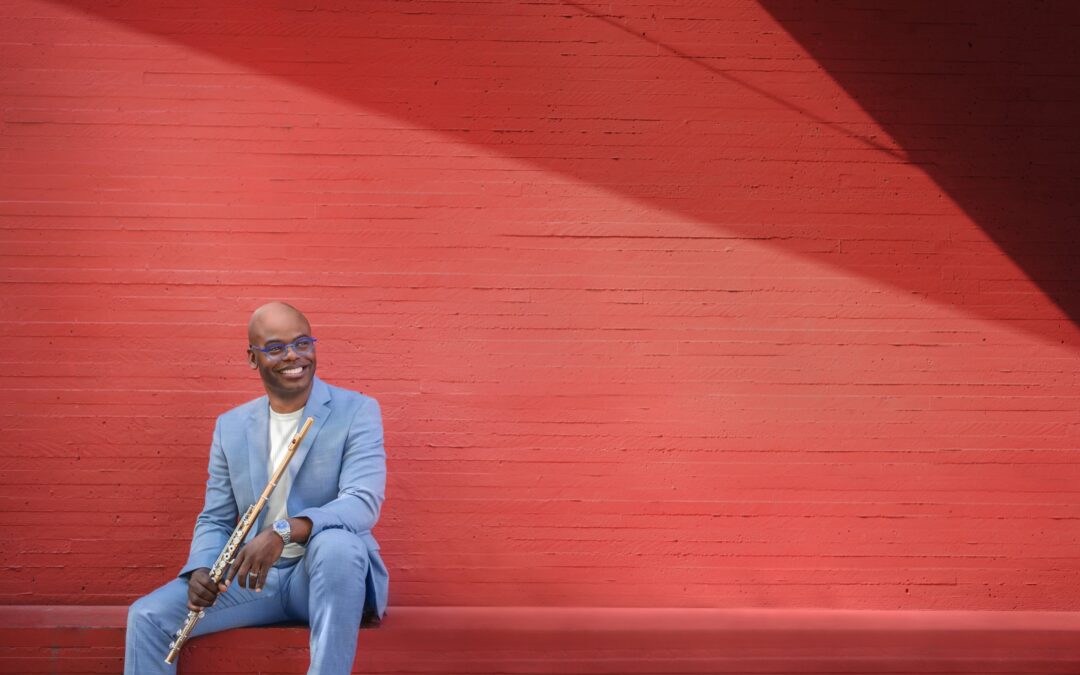Flutist Demarre McGill will solo on C.P.E. Bach’s most famous flute concerto. Photo by Carlin Ma.
By Montague Gammon III
A genuinely out-of-this-world little symphony begins each concert in the March 28-30 series of Virginia Symphony Orchestra performances in Norfolk, Newport News and Virginia Beach.
Led by VSO Principal Guest Conductor Thomas Wilkins, the concerts will also feature a flute concerto by the forward-thinking C.P.E. Bach, the most highly acclaimed of J.S. Bach’s musical and numerous progeny, and will close with the last composed and most famous of Mozart’s symphonies, Symphony No. 41, familiarly known as the Jupiter Symphony.
That truly high-flying curtain raiser, by contemporary multi-genre composer and Musical America’s 2022 Composer of the Year, Missy Mazzoli, is titled “Sinfonia (for Orbiting Spheres).” It’s about ten minutes of what might be called a musical thought experiment, imagining a Medieval, hand cranked stringed instrument called a hurdy-gurdy “propelled through space” (quoting Wilkins).
“Sinfonia” precedes what seems to be the first VSO performance in recent memory of any work by Carl Philipp Emanuel Bach. (Nor have we often heard the harpsichord, as we will during this performance of his mid-18th Century, 22-25 minute Concerto for Flute in D minor.)
C.P.E. Bach, as he is known for economies of breath and time, is usually considered the most forward looking of the several musical progeny sired by the artistically and literally prolific Johann Sebastian Bach. (Twenty kids, ten living to adulthood.)
The younger Bach’s flute concerto brings to the stage soloist and, by happenstance, Wilkins’ family friend and professional collaborator of some quarter century, Demarre McGill. McGill has built an international reputation as a solo flutist while also serving as principal flute for some half dozen of America’s highly regarded orchestras, including being acting principal for the Met Opera.
Finally, there is the Jupiter Symphony, by the composer whose name, next only to Beethoven’s, absolutely means classical music across the English speaking world. Mozart’s Symphony No. 41, “Jupiter,” was finished August 10, 1788, three years and a little less than four months before he died at 35. It’s likely he never heard played this piece that is regarded, not only as one of his masterpieces, but as one of the greatest of all symphonic masterpieces.
Conductor Wilkins made time for a phone chat sandwiched between classroom duties as a full professor and holder of the Henry A. Upper Chair of Orchestral Conducting at the Indiana University Jacobs School of Music.
Mazzoli’s Sinfonia is the only one of her works he has conducted, but he “kind of fell in love” with it “when [he] stepped in at the last minute” a few years ago because of a cancellation “to conduct a program with the Florida Orchestra” which included the 2014 (revised 2016) composition. “I did a little research on her,” he said, terming Mazzoli, “prolific and busy and just kind of all over the place and very creative.”
The work is variously eerie and unvaryingly compelling, other worldly in sound, often filled with a sense of beckoning, thoroughly fascinating, unmistakably music of the spheres, attuned to the cosmos and our whirling solar system and galaxy and possessing, in Wilkins’ words, a “whole notion of this spatial outside-ness, atmospheric kind of writing.”
C.P.E. Bach is routinely referred to as having bridged the Baroque and the Classical eras of (lower case c) classical music, pointing the way from what Wilkins described as the “ornateness of the Baroque period” to the “rationality” and the “notion of simplicity…rhythmic clarity” that are among the “hallmarks of the Classical period.”
Wilkins on this Bach flute concerto: “It’s delightful…absolutely lovely and the audience is going to love it…We have come out of a world, and I’m talking about the prior piece on the program…that not a lot of people are used to…By the time we get to C.P.E. Bach it sort of brings them back to something a little more familiar from a sound world perspective. It’s the right piece at the right time in the life of the program.”
Then there is, always, the genius of Mozart.
“Mozart’s Jupter is one of my favorites,” Wilkins said. “When I’m in front of this music you see his genius…his ability to work out ideas without a lot of wordiness. He can be clever without being unclear…Another thing for me is that all the parts fit correctly When I see something on the page, I run across something, I say, ‘That’s a great idea, that’s perfect for this spot, but I know that I never would have thought of it on my own.’…the Second Movement, I mean that melody (he sings it wordlessly) it’s like an aria, and that’s another thing about Mozart, he writes his symphonic music as if he includes the dramatic [feel] of his operas.”
Curious little coincidence: One of the earliest documented public references to this Mozart that used its informal title, an ad for a printed score in the London daily newspaper “The Morning Post” of June 3, 1817, read “The celebrated movement from Mozart’s sympathy [sic], called ‘Jupiter’, arranged as a Duet, by J. Wilkins, 4s.”
Really, no one can say for sure when and why it became the “Jupiter Symphony.” One informed guess is that it is as grand as the head of the Roman gods himself. Another hypothesis is that it was so powerful that it reminded a music publisher of Jupiter’s lightning bolts.
WANT TO GO?
Mozart’s Jupiter Symphony
Virginia Symphony Orchestra
Thomas Wilkins, conductor
Demarre McGill, flute
Missy Mazzoli: Sinfonia (for Orbiting Spheres)
C.P.E. Bach: Concerto for Flute in D minor
Wolfgang Amadeus Mozart: Symphony No. 41, “Jupiter”
7:30 p.m., Fri., March 28, Chrysler Hall, Norfolk
7:30 p.m., Sat. March 29, Ferguson Center for the Arts, Newport News
2:30 p.m., Sun., March 30, Sandler Center for the Performing Arts, Virginia Beach
757-892-6366




